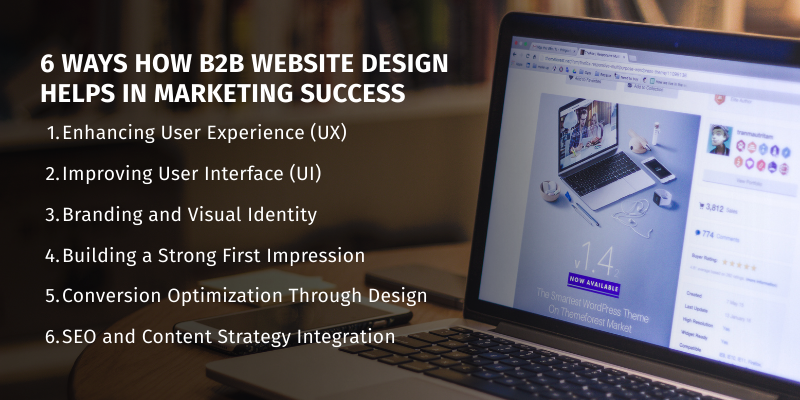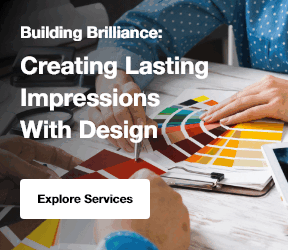When it comes to B2B marketing, your website is often the first place potential clients interact with your brand.
This makes website design one of the most important aspects of attracting and engaging businesses.
A well-designed website doesn’t just look appealing—it creates an impression of professionalism, establishes trust, and boosts your credibility.
These elements are crucial for turning leads into lasting business relationships.
But it's not just about aesthetics.
The design should focus on providing a smooth user experience, clearly showcasing your brand's values, and making navigation as easy as possible.
From the color scheme to the layout and even how content is presented, every little detail influences how clients perceive your business.
In this article, we’ll break down how different aspects of your website’s design can make or break your B2B marketing efforts.
By getting a better grasp of these factors, you'll be able to fine-tune your website to build trust, increase engagement, and ultimately drive more conversions.
A comprehensive digital marketing service can help integrate these design elements into a broader strategy for maximum impact
6 Ways How B2B Website Design Helps In Marketing Success
In today’s digital age, more and more prospects are turning to the internet to find solutions your business offers.
Without a website, how will they ever discover you?

But having a website isn’t just about being visible online; it also brings a host of other valuable benefits, including:
1. Enhancing User Experience (UX)
User experience (UX) is at the core of any successful B2B website. It focuses on optimizing the interaction between the user and the website, ensuring a seamless and intuitive experience.
An intuitive UX design allows these visitors to quickly find what they’re looking for, improving their overall experience and increasing the chances of conversion.
One of the critical elements of UX design is easy navigation. A website must have a logical and straightforward structure, allowing users to move between sections with minimal effort.
If visitors cannot quickly locate the information they need, they may become frustrated and leave, which leads to missed opportunities.
Clear call-to-action (CTA) buttons are another crucial component of effective UX design. To understand their importance in detail, explore what is CTA and how it drives user engagement. hese CTAs guide users toward the desired action, such as signing up for a demo, requesting a quote, or downloading a resource.
A well-placed and compelling CTA increases the likelihood that users will take the next step in their journey, making it an essential part of the B2B conversion process.
2. Improving User Interface (UI)
User Interface (UI) plays a crucial role in B2B marketing by creating a visually appealing, consistent, and professional design that enhances user trust and engagement.
Consistency in UI elements, such as buttons, fonts, and images, is vital for a coherent and professional look across the website.
Consistent design ensures that users can easily navigate the site without confusion. It helps them understand the functionality of different elements at a glance.
Whether it's the shape of buttons, the style of fonts, or the quality of images, consistency enhances usability and reinforces brand identity, providing a unified and polished experience.
UI design directly affects how a business is perceived by its audience. A clean, modern, and professional design fosters trust, signaling that the business values quality and attention to detail.
On the other hand, a disorganized or outdated UI may lead users to question the business's reliability.
3. Branding and Visual Identity
Branding and visual identity are crucial aspects of website design, helping to create a consistent and cohesive reflection of a company’s values.
For B2B businesses, this consistency fosters professionalism and trust, making it easier to build strong relationships with potential clients.
Visual elements like logos, color schemes, and typography play a vital role in reinforcing a brand’s identity on the website.
-
Logo: The logo is often the first thing users notice, and its prominent placement on the website helps reinforce brand recognition.
-
Color Palette: The chosen color palette should align with the emotional tone of the brand, blues convey trust, reds convey energy, and greens convey sustainability, creating an immediate emotional connection with the audience.
-
Typography: The font style should match the tone of the brand. Whether it's modern and sleek or traditional and reliable, typography shapes the way potential clients perceive the brand.
Together, these visual elements play a crucial role in shaping the overall perception of the brand. For inspiration, check out these advertisement examples that showcase how visuals can enhance brand identity.
4. Building a Strong First Impression
The visual appeal of a website plays a crucial role in establishing instant credibility with business clients.
A well-designed website that is visually engaging, clean, and professional immediately captures attention and conveys trustworthiness.
For B2B businesses, making a strong first impression is essential for converting visitors into clients. A polished design demonstrates that the company values quality and attention to detail, making clients more likely to trust and engage with the brand.
For businesses considering e-commerce platforms, questions like is Shopify legit often arise when evaluating tools to build a trustworthy online presence.
5. Conversion Optimization Through Design
Conversion optimization through design focuses on strategically placing and designing compelling CTAs that drive user actions and maximize conversions. Understanding what is a conversion funnel can help in strategically improving these aspects.
-
Call-to-Action (CTA) Buttons
CTAs like “Request a Demo” or “Contact Us” should be prominently placed near key content, such as product descriptions or after important sections, to maximize user interaction.
Use clear, action-oriented language like “Start Your Free Trial” and ensure the button design stands out with contrasting colors and appropriate size for easy clicking.
-
Strategic Placement of CTAs
Position CTAs above the fold, after content, or at the end of blog posts for optimal visibility. Multiple CTAs and mobile responsiveness boost conversion chances.
-
Landing Pages
A focused, user-intent-aligned landing page is crucial for conversions, with a clear value proposition and simple, engaging layouts that lead visitors toward taking action.
-
Effective Lead Capture Forms
Keep forms short and request only essential details like name and email. Position forms prominently and use engaging CTAs like “Get Started” to increase conversion rates.
6. SEO and Content Strategy Integration
A well-designed site, with key features of a successful B2B website, not only makes it easier for visitors to navigate but also helps search engines crawl and index the content more efficiently.
With mobile-first indexing being a priority for search engines like Google, a mobile-friendly website is essential for maintaining high rankings.
Website speed directly affects both user experience and SEO. Partnering with a professional SEO service can help optimize your site’s performance and improve search rankings
directly affects both user experience and SEO. Slow-loading pages lead to high bounce rates, which can hurt rankings. Search engines prioritize fast-loading websites, as they improve the user experience.
SEO-friendly content design integrates visual elements and optimized layouts to enhance user experience, improve engagement, and boost search engine rankings. To track your progress, consider using the best SEO reporting tools to measure and optimize your website’s performance.
Moreover, visual elements for SEO, such as images, infographics, and videos, make content more engaging, keeping visitors on the page longer, which can lower bounce rates and positively impact SEO rankings.
Conclusion
In summary, website design plays a pivotal role in B2B marketing by creating strong first impressions, building trust, and driving conversions.
Key elements like user experience (UX), user interface (UI), branding, and visual identity all contribute to an engaging, professional website that fosters credibility and authority.
Additionally, strategic design of landing pages, CTAs, and lead forms, along with SEO integration, ensures that a website not only attracts visitors but also converts them into valuable clients.
As client expectations evolve and technology advances, businesses must continuously optimize their website design to stay competitive. For those looking to stay ahead, learning about emerging technologies like how to learn AI can provide a competitive edge in optimizing digital experiences.
Whether it’s adapting to mobile-first indexing, enhancing site speed, or ensuring content is structured for SEO, keeping up with design trends and technological improvements is crucial for long-term success.
By leveraging website design as a powerful marketing tool, B2B businesses can differentiate themselves, improve user engagement, and ultimately gain a competitive edge in their respective industries. Partnering with a B2B marketing service can further amplify these efforts with tailored strategies
A well-designed website is more than just a digital presence; it’s a key driver of business growth and success.








